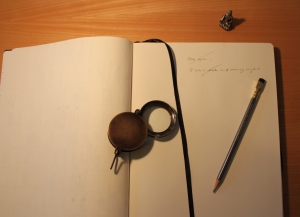 You haven’t heard from me for a long time. It can be good to take a break from reviewing productivity apps and to focus solely on Getting Things Done®. For me, that has meant a new landmark project: I am currently working on my debut novel, and I am well into my first draft. Let me tell you what that means to me.
You haven’t heard from me for a long time. It can be good to take a break from reviewing productivity apps and to focus solely on Getting Things Done®. For me, that has meant a new landmark project: I am currently working on my debut novel, and I am well into my first draft. Let me tell you what that means to me.
I started writing when I was nine years old (poetry, short stories) and I have written—mainly in a professional capacity—ever since. Reports, manuals, school books, briefings, speeches, websites, literary criticism, e–learning modules—you name it.
But never a novel.
Writing a novel is something I have always wanted to do. At school I secretly imagined myself as a gaunt bohemian writer in a garret. But life got in the way, of course, and for that I am grateful too. I experienced the garret for a while but did not get much writing in.
In July 2011 I revisited my dream and decided to work towards making my novel a reality. I started thinking about some of the unsettling issues that I had encountered in the course of my career, working in education, child protection and mental health over three decades. I started developing fictitious characters who were based in each of those areas.
A basic plot started to take shape, but every step I completed morphed into at least three new tasks. Among my other roles, I had been a project manager, but could I manage a writing job of this scope and magnitude? When writing a manual or a report, the path ahead was usually well–defined. Here I was on my own, with just 26 letters, some blank pixels, a crate of second–hand punctuation marks, my memory and my imagination.
By the middle of 2014 I had worked on my novel only sporadically. I had been busy completing a number of writing and research projects instead. They were only short–term commitments, I kept telling myself. But they filled my days and kept my writing within its comfort zone—the clear boundaries of academic and technical writing.
I had developed a fairly detailed outline of my novel (yes, I am that kind of writer), backstories for the main characters and written about 15 per cent of the text. Then I stalled. There was a scene that I just could not nail. Bypassing it did not work either. I felt paralysed—by fear of failure. What if I could not complete the novel? What if it was beyond me? Then it dawned on me: sure, like with everything in life, there was the risk of failure. But inaction meant giving up on a dream and brought the certainty of failure.
So, in January of this year I dusted off the right hemisphere of my brain, put new batteries in my mouse and wrote some awful paragraphs that no one other will ever see. I persisted with that beachhead and after a couple of days on the foreign shores of creativity, my writing became more fluent again. My tally is now up to 48,000 words and by my own estimate this means I am 45 per cent into my first draft. And yes, maybe I will not finish this novel or maybe it won’t be any good, but at least I’m still in there with a chance, and I am improving the odds by writing every day. The working title for the novel? Resilience…
This is my invitation to you to follow me on this journey.
I intend to tell you more, over the coming months, about my Great Writing Adventure. About some of the challenges I have encountered, my learning from style gurus maybe. The tools that I use to collect ideas (Evernote), to write them up (Scrivener) and to keep track of the whole project (Omnifocus).
You see, I ended up talking about productivity apps after all.

Glad yo hear from you again, I have missed your perceptive articles.
Will look forward to hearing how things develop
Bill
LikeLike
Thanks, Bill. I am glad you enjoy my writing. I’ll try to keep you interested!
LikeLike
Hi. Looking forward to hearing about the book project. I’d also be interested in hearing how you are getting on with Omnifocus 2, or are you still using Omnifocus 1?
LikeLike
I am using Omnifocus 2 and loving it. I tweak my folder structure every two months or so, as priorities change. You may want to check out my post about OF2 on this blog or Dini Kourosh’s pricey but excellent work on Creating Flow with Omnifocus 2. Thank you for leaving a comment!
LikeLike
Hi Gilbert, thanks for sharing details of your project and the tools you’re using. I look forward to hearing more of your progress and I’ll certainly investigate the apps you mention.
LikeLike
Thanks Adrian, Omnifocus is a Mac-only app, but Evernote and Scrivener work on Windows too.
LikeLike